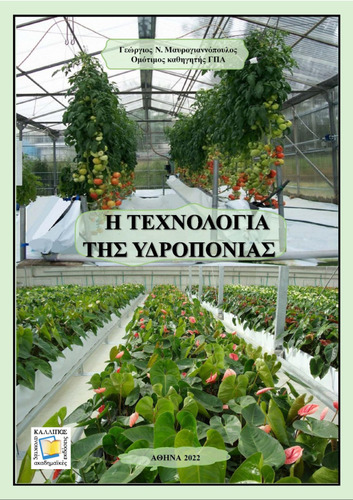| Title Details: | |
|
The Technology of Hydroponics |
|
| Authors: |
Mavrogiannopoulos, Georgios |
| Subject: | NATURAL SCIENCES AND AGRICULTURAL SCIENCES MEDICINE AND HEALTH SCIENCES, LIFE SCIENCES, BIOLOGICAL SCIENCES > LIFE SCIENCES > FUCTIONAL AND ORGANISMIC BIOLOGY > AQUATIC/MARINE BIOLOGY |
| Keywords: |
Hydroponics
Soilless culture Hydroponic systems Root environment Plant nutrition Inorganic plant nutrients Fertilization Irrigation Calculation of inorganic nutrients in hydroponics The pH of the nutrient solution Salinity of nutrient solution Root system temperature |
| Description: | |
| Abstract: |
The book provides useful information for the student, grower, and anyone interested in hydroponics and how this method of plant production works as applied to a wide range of growing conditions. Hydroponics refers to the technology of growing horticultural plants without using natural soil. The plants are cultivated either in a pure water solution with inorganic salts (fertilizers), or mainly on inert, porous substrates to which the nutrient solution is added. Hydroponic cultivation is an expanding method of agricultural production, mainly in the greenhouse area, because by optimizing the environment of the crown, which is achieved with the greenhouse, and the environment of the root which is achieved with hydroponics, plant yields increase (up to and over a tenfold degree compared to an outdoor cultivation) and the quality of the produced products is improved. Hydroponics began after the 18th century as a tool for academic research in plant nutrition and much later (20th century) evolved into a production method. The root and the effects of the root environment (such as water, substrate porosity, salt concentration, temperature, pH and microorganisms) determine plant growth and performance. Both in the case of the soil and in the case of hydroponics, the root is the filter that controls the entry of various chemical elements into the plant's organs. The environment in which plant organisms develop determines to what extent the characters determined by their genetic potential (DNA) can be developed and therefore the potential for a successful production. Today, many methods of hydroponics (to regulate the root environment) have been developed and are applied internationally, such as cultivation in a shallow flowing nutrient solution, cultivation in nutrient solution reservoirs, cultivation in sprayed nutrient solution (aeroponics), cultivation in inert materials, and cultivation in organic substrates. The inorganic elements (ions) of fertilizers are irreplaceable for the growth and production of plants. However, due to the interactions between ions and their competition, the various ions that make up plant nutrients, must be in the proper proportion to each other in the solution around the root. Of course, the optimal relationships between these elements are not the same for all species of plants, not even during the entire cultivation period. The basic composition of the nutrient solution must be adapted appropriately during the different phases of the plants and changes in the environment, e.g., during the vegetative growth of plants, at the beginning of fruiting, or when there is high humidity, low temperature, sunshine etc. In order to create the appropriate nutrient solution each time, the necessary calculations are made to determine the required amounts of inorganic nutrients and to determine the weight of the related fertilizers. With the proposed method, it is possible to change the electric conductivity of the solution to be used without changing the ratio between basic nutrients and to correct the composition based on the ions contained in the irrigation and drainage water. Except for soil crops and in hydroponic crops, harmful fungi and other microorganisms can grow in the root environment. Protection measures against pathogenic microorganisms are therefore also useful in hydroponic crops.
|
| Linguistic Editors: |
Kalogeridi, Violeta |
| Graphic Editors: |
Tsakmaki, Eleni |
| Type: |
Undergraduate textbook |
| Creation Date: | 25-11-2022 |
| Item Details: | |
| ISBN |
978-618-5726-26-3 |
| License: |
Attribution - NonCommercial - ShareAlike 4.0 International (CC BY-NC-SA 4.0) |
| DOI | http://dx.doi.org/10.57713/kallipos-150 |
| Handle | http://hdl.handle.net/11419/8772 |
| Bibliographic Reference: | Mavrogiannopoulos, G. (2022). The Technology of Hydroponics [Undergraduate textbook]. Kallipos, Open Academic Editions. https://dx.doi.org/10.57713/kallipos-150 |
| Language: |
Greek |
| Consists of: |
1. Introduction 2. The root and its environment 3. Hydroponic farming systems and methods 4. Regulation of crop systems 5. Calculation of the composition of nutrient solutions 6. Protection measures against root pathogens |
| Number of pages |
196 |
| Publication Origin: |
Kallipos, Open Academic Editions |
| You can also view | |
| User comments | |
There are no published comments available! | |

